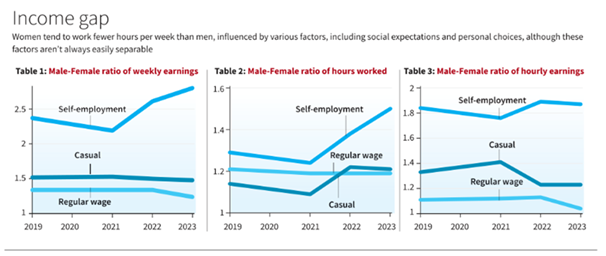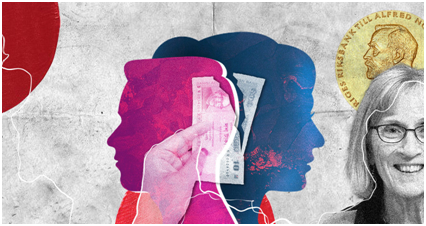Gender Pay Gap


Gender Pay Gap
Current Affairs Daily News & Issues
La Excellence IAS Academy | October 26, 2023
Gender Pay Gap

Why in the News?
Periodic Labour Force Survey (PLFS) Annual Report 2022-2023 Released.
Issue: Labour force rises but wage growth slows, gender pay gap widens says PLFS Report .
Need for Periodic Labour Force:
- Considering the importance of the availability of labor force data at more frequent time intervals, the National Sample Survey Office (NSSO) launched the Periodic Labour Force Survey (PLFS) in April 2017.
The objective of PLFS is primarily twofold:
- To estimate the key employment and unemployment indicators (viz. Worker Population Ratio, Labour Force Participation Rate, Unemployment Rate) in the short time interval of three months for the urban areas only in the ‘Current Weekly Status’ (CWS).
- To estimate employment and unemployment indicators in both ‘Usual Status’ (ps+ss) and CWS in both rural and urban areas annually.
Five Annual Reports covering both rural and urban areas giving estimates of all important parameters of employment and unemployment in both usual status (ps+ss) and current weekly status (CWS) have been released.
These five Annual Reports are brought out on the basis of data collected in PLFS during July 2017- June 2018, July 2018-June 2019, July 2019-June 2020, July 2020 – June 2021, and July 2021-June 2022.
Now the Sixth Annual Report is being brought out by NSSO on the basis of the Periodic Labour Force Survey conducted during July 2022-June 2023.
Key Findings of PLFS, Annual Report 2022-2023:


- Increasing Trend in Labour Force Participation Rate and Worker Population Ratio.
- Constant Decrease in Unemployment Rate.
- Increasing Trend in Labour Force Participation Rate (LFPR) for persons aged 15 years and above
- In rural areas, LFPR increased from 50.7% in 2017-18 to 60.8% in 2022-23 .
- In urban areas it increased from 47.6% to 50.4%.
- LFPR for males in India increased from 75.8% in 2017-18 to 78.5% in 2022-23 and a corresponding increase in LFPR for females was from 23.3% to 37.0%.
How big is the gender gap in earnings?


What are the main findings regarding the earnings gap between men and women across different forms of employment in 2023?
- The Periodic Labour Force Surveys (LFS) has been monitoring the gender forms of employment from April-June 2019 to 2021.
- This latest round has introduced a crucial focus on weekly hours worked, revealing that the Inequality in total earnings might not capture the full picture.
- Women, on average, work longer hours than men, attributed to a combination of social pressures and personal choices highlighting the complex interplay however societal norms and individual decisions in shaping gender disparities in the workforce.
- Labour force participation has increased, but it has resulted in depressed wage growth and a widened gender pay gap.
- The average wage growth rate for regular salaried employees in urban areas declined from 8.3% to 4.9% in 2022-23.
- The decline was more pronounced for lower-paying jobs.
- The gap between male and female earnings at managerial levels increased, and women faced higher job losses during economic downturns.
How does the gender earnings gap differ?


- Men consistently earn more than women in all forms of work, with the greatest gender gap observed among self-employed individuals.
- The gender gap in earnings has Increased for self-employed workers but decreased for regular-wage workers.
- A focus on weekly hours worked reveals that women, on average, work fewer hours than men, with the largest gap in self-employment.
- The rise in the gender gap in hours worked is attributed to increasing Labour force participation rates (LFPRS) among rural women in self-employment, but with many of these jobs being part-time in nature.
- In terms of of hourly earnings, the gap is significantly reduced for regular wage workers, with men earning 24% more in 2023 and working 19% longer hours.
Defining the Gender Pay Gap
- The gender pay gap is the difference in average gross hourly earnings between women and men.
- It is calculated based on salaries paid directly to employees before income tax and social security deductions.
- Typically, calculations consider companies with 10 or more employees.
What Causes the Gender Pay Parity?
The gap between women’s and men’s average earnings is the result of social and economic factors that combine to reduce women’s earning capacity over their lifetime.
These factors include:
- Conscious and unconscious discrimination and bias in hiring and pay decisions
- Under-representation in leadership
- Women and men working in different industries and different jobs, with female-dominated industries and jobs attracting lower wages
- Women more than men are more likely to take career breaks from their employment in order to raise children. That makes them likely to have fallen behind in advancement and in remuneration.
- Lack of workplace flexibility to accommodate caring and other responsibilities, especially in senior roles
- High rates of part-time work for women
- Women’s greater time out of the workforce for caring responsibilities impacts career progression and opportunities
- It can be challenging for them to obtain and maintain a job in science, technology, engineering and mathematics (STEM) disciplines because they are traditionally male-dominated.
How Can We Reduce Gender Pay Parity?
To remove the obstacles preventing women from participating fully and equally in the workforce, a cultural shift is necessary to close the gender wage gap.
Some of the ways to reduce the gender pay gap include:
- Conducting an audit to understand the size of the gender pay gap
- Reporting the findings to management and employees
- Promoting a gender-inclusive business culture while adopting a holistic approach to equal remuneration for women and men for work of equal value.
- Taking action to increase the number of women in leadership positions
- Encouraging men to access flexible work arrangements and leave entitlements.
- Making jobs more flexible so that more women access higher-level jobs and, therefore, higher pay.
- Making equitable salary offers to men and women.
- Encouraging women’s participation in leadership roles as well.
- Women’s education must be promoted.
The Gender Pay Gap differs from Equal Pay:
Equal pay mandates that individuals of all genders receive the same compensation for identical roles or work of equal value.
On the other hand, the Gender Pay Gap does not concern comparing similar roles; instead, it highlights the disparity in average pay between men and women within organizations, industries, and the workforce at large.
Closing the Gap: Benefits
- The gender pay gap tends to increase with age and growing family responsibilities, making women more vulnerable to poverty and social exclusion as they age.
- Closing this gap would enhance gender equality, reduce poverty, stimulate the economy, and increase the tax base.
- Estimates suggest that reducing the gender pay gap by one percentage point would boost the gross domestic product by 0.1%.
Steps taken by India
India has taken several steps in the legislative sphere to close the gender pay gap, especially at the low end of the wage distribution.
- The Minimum Wages Act in 1948 .
- The adoption of the Equal Remuneration Act in 1976.
- In 2019, India carried out comprehensive reforms in both the legislation and enacted the Code on Wages.
- In 2017, the Government amended the Maternity Benefit Act of 1961, which increased the ‘maternity leave with pay protection’ from 12 weeks to 26 weeks for all women working in establishments employing 10 or more workers.
- The Skill India Mission to equip women with market-relevant skills to bridge the learning-to-livelihood gap and the gender pay gap.
While the gender pay gap is slowly narrowing, at the current rate of progress it will take more than 70 years to close it completely.
Accelerated and bold action is needed to prevent a widening of the gender pay gap and closing the existing gap.
One of the targets of the UN Sustainable Development Goal 8 is “achieving full and productive employment and decent work for all women and men, including for young people and persons with disabilities and equal pay for work of equal value” by 2030. In support of this Goal, the Equal Pay International Coalition (EPIC), was launched in 2017 as a multi-stakeholder initiative led by the ILO, UN Women and the Organisation for Economic Co-operation and Development (OECD) that seeks to achieve equal pay for women and men everywhere.
Equal pay for work of equal value is necessary to close the gender pay gap. Closing the gender pay gap is key to achieving social justice for working women, as well as economic growth for the nation as a whole.
Leave a Reply
You must be logged in to post a comment.
